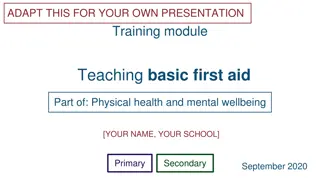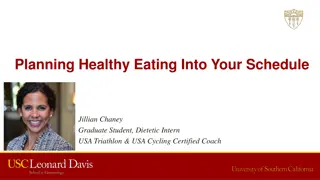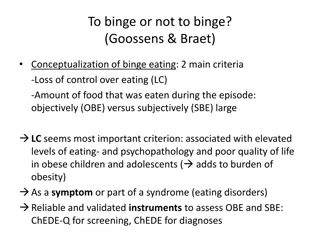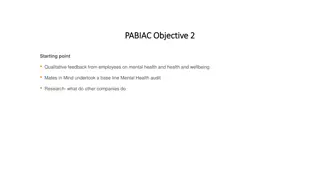Training Module on Teaching Healthy Eating for Physical and Mental Wellbeing
This training module focuses on teaching healthy eating to promote physical health and mental wellbeing in primary and secondary schools. Subject leads can utilize the slides, activities, and templates provided to enhance teachers' training sessions. By the end of this training, participants will be equipped with strategies and knowledge to confidently educate students on healthy eating practices. Relevant topics, related guidance, and curriculum integration are also discussed to ensure a comprehensive approach to health education.
Download Presentation

Please find below an Image/Link to download the presentation.
The content on the website is provided AS IS for your information and personal use only. It may not be sold, licensed, or shared on other websites without obtaining consent from the author.If you encounter any issues during the download, it is possible that the publisher has removed the file from their server.
You are allowed to download the files provided on this website for personal or commercial use, subject to the condition that they are used lawfully. All files are the property of their respective owners.
The content on the website is provided AS IS for your information and personal use only. It may not be sold, licensed, or shared on other websites without obtaining consent from the author.
E N D
Presentation Transcript
ADAPT THIS FOR YOUR OWN PRESENTATION Training module Teaching about healthy eating Part of: Physical health and mental wellbeing [YOUR NAME, YOUR SCHOOL] Primary Secondary November 2020
Contents 3 About this training module 5 Teaching the new curriculum 13 Safeguarding 15 Ground rules 18 Primary curriculum 46 Secondary curriculum 81 Examples of good practice 84 Activities and templates for trainers 2
About this training module Subject leads can use the adaptable slides and activities and templates for trainers section at the end of this module to help shape training sessions for teachers. This non-statutory training module supplements the statutory guidance on teaching healthy eating, which schools should read in full. Schools can choose whether and how to follow or adapt this training module and should refer to the Early Career Framework for pedagogical guidance. 3
What you get out of today By the end of this training you should: know what is included in the statutory guidance know some key knowledge and facts to cover as part of this topic have strategies to deal with questions that come up in class feel more confident teaching about healthy eating 4
Related topics Healthy eating is related to the curriculums for: Design and Technology, i.e. food teaching in primary and secondary schools and cooking and nutrition Science The following modules also have related content: physical health and fitness; drugs, alcohol and tobacco; health and prevention. You should: consider thematic links across key topics and the whole school when planning and delivering lessons find ways to link knowledge and vocabulary across topics 6
Related guidance Schools may also want to refer to the following related government guidance when planning to teach this subject: the Eatwell guide shows how much of what we eat overall should come from each food group standards for school food in England Also refer to your school s policy on healthy eating. 7
Healthy eating support at [school name] Our leads [Names, contact details - e.g. PSHE lead] Our policies [Add details - e.g. school policy on PSHE, training opportunities, and healthy eating] Specialist support [Add details - e.g. providers school already works with] Other information [Add resources] 8
Healthy eating teaching at [school name] Ways in which we already teach about healthy eating at our school: [Add details] [Add details] [Add details] 9
Primary and secondary teaching Some slides in this training have a Primary or Secondary label to indicate that the material is usually first introduced in that phase. STATUTORY GUIDANCE Schools have flexibility to design and plan age-appropriate subject content. (p31) Using your knowledge of your pupils and school community you can: introduce secondary content in primary with pupils who need it and are ready teach the primary content in early secondary lessons to pupils who need to build knowledge before secondary content is taught 10
Pupils with SEND You will need to plan lessons to allow all pupils to access and practise the core knowledge, using your expertise as you normally would. You might want to link lesson outcomes with statutory preparing for adulthood outcomes for those with an education, health and care (EHC) plan. (See SEND code of practice, section 8.) STATUTORY GUIDANCE In special schools and for some SEND pupils in mainstream schools there may be a need to tailor content and teaching to meet the specific needs of pupils at different developmental stages. As with all teaching for these subjects, schools should ensure that their teaching is sensitive, age-appropriate, developmentally appropriate and delivered with reference to the law. (p15) 11
Teacher wellbeing The new curriculum covers a wide range of topics, some of which individual teachers might find personally challenging in different ways. It is important to feel you can ask for support or raise questions if: you have personal experience of a topic which makes teaching that content particularly challenging for you you have personal views on a topic that mean you need to discuss how you can ensure the teaching is delivered objectively Talk to your line manager, in the first instance, if you do need support. 12
Safeguarding 13
Safeguarding (1) Pupils may be affected by issues discussed in lessons. Let your designated safeguarding lead or deputy and any other relevant staff, such as pastoral leads, know what you are teaching. This will enable them to identify and speak to relevant pupils, especially those who they know may have been directly impacted by issues covered in the lessons and those with adverse childhood experiences. Teachers may need to deal with disclosures or concerns (e.g. of abuse or offending behaviour) in a way that safeguards pupils in line with school policies, especially the child protection policy. 14
Ground rules 15
Create class ground rules Clear class ground rules can help when teaching about sensitive topics. They also support confidentiality and safeguarding of pupils. Good practice is for ground rules to be: discussed and understood by all clear and practical modelled by the teacher followed consistently and enforced updated when needed visible in lessons (for example, posters) 16
Example ground rules Respect privacy. We can discuss examples but do not use names or descriptions that identify anyone, including ourselves. Listen to others. It is okay to disagree with each other, but we should listen properly before making assumptions or deciding how to respond. When disagreeing, challenge the statement not the person. No judgement. We can explore beliefs and misunderstandings about a topic without fear of being judged. Choose level of participation. Everyone has the right to choose not to answer a question or join discussion. We never put anyone on the spot (no personal questions or pressure to answer). 17
A healthy diet (1) STATUTORY GUIDANCE Know what constitutes a healthy diet (including understanding calories and other nutritional content). Explain that a healthy diet helps our bodies to grow, stay healthy, function properly and fight off diseases. A healthy diet has the right balance of nutrients. These are substances in food which provide the nourishment we need to maintain health and growth. Explain that we need to eat a wide variety of food and drink in the right amounts to get these nutrients. Primary 20
A healthy diet (2) STATUTORY GUIDANCE Know what constitutes a healthy diet (including understanding calories and other nutritional content). Explain that different nutrients can be found in different foods, and most foods have several types of nutrient: carbohydrates, from starchy food like potatoes, bread, rice, pasta, fruit and vegetables protein, e.g. from beans, pulses, fish, eggs, meat and dairy fats, e.g. from meat, dairy, and plant and fish oil Primary 21
A healthy diet (3) STATUTORY GUIDANCE Know what constitutes a healthy diet (including understanding calories and other nutritional content). vitamins and minerals, which are found in different foods, and especially fruit and vegetables. A well-balanced diet will include at least 5 portions of fruit and vegetables a day. A portion is about a handful (80g or 3oz), for example: 4 broccoli florets 1 pear 3 heaped tablespoons of carrots Explain that we also need fibre from foods such as beans, pulses, wholegrain pasta and rice, broccoli, carrots, nuts and seeds. Primary 22
Carbohydrates (1) STATUTORY GUIDANCE Know what constitutes a healthy diet (including understanding calories and other nutritional content). Carbohydrates are the body s main source of energy. The length of time it takes the body to convert them into energy (in the form of glucose) determines whether they are a complex or simple carbohydrate. Explain that our bodies digest complex carbohydrates more slowly meaning the energy is released gradually. Energy that is not needed straight away is stored in the muscles and liver, or as fat. Complex carbohydrates can be found in starchy foods, e.g. potatoes, bread, rice, pasta, oats. Primary 23
Carbohydrates (2) STATUTORY GUIDANCE Know what constitutes a healthy diet (including understanding calories and other nutritional content). Explain that simple carbohydrates are sugars and are converted into energy and used more quickly than complex carbohydrates. They occur naturally in fruit and milk. Simple carbohydrates are also present in sugar and in processed food, e.g. in sweets, chocolate, biscuits and cakes. Primary 24
Protein STATUTORY GUIDANCE Know what constitutes a healthy diet (including understanding calories and other nutritional content). Teach that protein is a macronutrient which is essential for building muscle mass in our body. Our bodies need protein in the diet to supply amino acids for the growth and repair of our cells and tissues. This includes our bones, muscles, cartilage, skin and blood. Protein is found in foods such as meat, fish, eggs, dairy products, tofu, beans and lentils. Primary 25
Fats (1) STATUTORY GUIDANCE Know what constitutes a healthy diet (including understanding calories and other nutritional content). Teach that fat is essential for our bodies. Fat is used for energy when we are physically active and it also helps the body to absorb vitamin A, vitamin D and vitamin E. Explain that there are two different types of fat in food, unsaturated (good fat) and saturated (bad fat). Most fats and oils contain both saturated and unsaturated fats in different proportions. Primary 26
Fats (2) STATUTORY GUIDANCE Know what constitutes a healthy diet (including understanding calories and other nutritional content). Teach that unsaturated (good fat) and saturated (bad fat) have different effects in our body. Explain that too much saturated fat (bad fat) in our body can build up over time and cause blockages in our arteries as adults. This is called bad cholesterol - a fatty substance in the blood. Unsaturated fat helps to reduce our bad cholesterol. It is found in vegetable oils, some nuts, avocados, and oily fish, e.g. sardines. Primary 27
Fibre STATUTORY GUIDANCE Know what constitutes a healthy diet (including understanding calories and other nutritional content). Explain that dietary fibre is important for digestion as it keeps the digestive tract flowing. Fibre is found in many foods that are high in carbohydrates, such as: beans and pulses wholegrain pasta and rice vegetables such as broccoli and carrots nuts and seeds Primary 28
Vitamins STATUTORY GUIDANCE Know what constitutes a healthy diet (including understanding calories and other nutritional content). Teach that vitamins are organic compounds that are need in small amounts for normal growth and activity by the body. They are naturally found in foods obtained from plants and animals. Explain that the essential vitamins are A, C, D, E, K, and the B vitamins. Vitamins have different jobs - helping us resist infections, keeping our nerves healthy, and helping our body get energy from food or our blood to clot properly. Primary 29
Minerals STATUTORY GUIDANCE Know what constitutes a healthy diet (including understanding calories and other nutritional content). Minerals also help our body function. They are only needed in very small quantities. Our body needs certain minerals to build strong bones and teeth and turn the food we eat into energy. As with vitamins, a healthy balanced diet should provide all the minerals our body needs to work properly. There are 16 essential minerals, including sodium (salt) and potassium, which can be found in bananas. Primary 30
Drinking enough fluids STATUTORY GUIDANCE Know what constitutes a healthy diet (including understanding calories and other nutritional content). Explain that the amount we need to drink varies on our size, the weather and how active we have been. Teach that when we are thirsty, our body is telling us that it is dehydrated and that we need to drink fluids. Any drink with water in it will hydrate us, but water is the best option as it is calorie and sugar free. Explain that if we do not drink enough fluid we become dehydrated. If we become too dehydrated it can be harmful to our health. Primary 31
Understanding calories (1) STATUTORY GUIDANCE Know what constitutes a healthy diet (including understanding calories and other nutritional content). Explain that a calorie is a unit of energy. Different foods have different amounts of calories. For example, if a food or drink contains 100 calories, it is a way of describing how much energy our body could get from eating or drinking it. Explain that the correct daily intake of calories will help to perform daily activities such as walking to school and playing with friends. Teach that if we consume more calories than we use, our body stores it up as fat. Primary 33
Understanding calories (2) STATUTORY GUIDANCE Know what constitutes a healthy diet (including understanding calories and other nutritional content). guidelines Explain that there are guidelines on how many calories it is appropriate to consume. The amount of calories we consume depends on our age, sex, weight, height, body fat percentage and how much physical activity we do. The guidelines suggest that ideally children aged: 4 to 6 years - girls have about 1400kcal, boys about 1500kcal 7 to 10 years - girls have about 1700kcal, boys about 1800kcal 11 to 14 years - girls have about 2000, boys 2500kcal Primary Teach that these figures are approximations. 34
Benefits of regular meals STATUTORY GUIDANCE Know the principles of planning and preparing a range of healthy meals. Explain that eating regular meals like breakfast, lunch and dinner every day helps us: plan a balanced diet which fulfils all our nutritional needs regularly consume the energy we need throughout the day avoid the effects of hunger, e.g. feeling low in energy, angry, irritated, or difficulty concentrating avoid too much snacking (food or drink we have other than during main mealtimes) Primary 36
Planning a range of meals (1) STATUTORY GUIDANCE Know the principles of planning and preparing a range of healthy meals. Teach that healthy meals can include a variety of foods to get a balance of nutrients which are healthy for the body. Every meal does not need to have every single nutrient, but on average can include the following: carbohydrates from starchy foods need to make up just over a third of everything we eat protein, e.g. from beans, pulses, fish, eggs, meat and dairy need to make up 10 to 20% vitamins and minerals, need to make up just over a third of what we eat fats, need to make up 20 to 30% fibre Primary 37
Planning a range of meals (2) STATUTORY GUIDANCE Know the principles of planning and preparing a range of healthy meals. Teach that a variety of foods are needed to get a balance of nutrients. Every meal does not need every single nutrient, but our overall food intake needs: starchy foods (carbohydrates) to make up about a third of our food and to include fibre vegetables and fruit (vitamins and minerals) to make up about a third of our food The rest of the diet should contain: beans, pulses, fish, eggs, meat and dairy (protein) fats, that as part of a balanced diet we will get all the fats we need from our diet Primary 38
Unhealthy diets STATUTORY GUIDANCE Know the characteristics of a poor diet and risks associated with unhealthy eating (including, for example, obesity and tooth decay) and other behaviours (e.g. the impact of alcohol on diet or health). Teach pupils that an unhealthy diet fails to provide the body with the correct amounts and types of nutrients for maximum health. Unhealthy diets can include some or all of the following: high in sugar high in salt high in bad fat (saturated fat) missing the right balance of nutrients lacking in vitamins and minerals lacking in fibre Primary 40
Impacts of unhealthy diets STATUTORY GUIDANCE Know the characteristics of a poor diet and risks associated with unhealthy eating (including, for example, obesity and tooth decay) and other behaviours (e.g. the impact of alcohol on diet or health). Teach that poor diets can lead to: feeling tired more easily having less energy for normal daily routines like walking to school, playing with our friends or other physical activity being less able to concentrate at school Explain that over time, unhealthy diets can lead to: tooth decay an unhealthy weight (overweight or underweight) obesity related conditions like type 2 diabetes Primary 41
Poor diet and tooth decay STATUTORY GUIDANCE Know the characteristics of a poor diet and risks associated with unhealthy eating (including, for example, obesity and tooth decay) and other behaviours (e.g. the impact of alcohol on diet or health). Explain that too much sugar causes tooth decay, a disease where teeth develop holes. Damage is caused by plaque in the mouth turning sugar into acid, which then damages the teeth. Tooth decay results in toothache, problems eating and can be very painful. It can lead to fillings or having teeth removed. Sugar (from both food and drink) is the main cause of tooth decay. Sugary snacks between meals can increase the risk. See the related module on health and prevention for guidance on good dental hygiene. Primary 42
Poor diet and unhealthy weight STATUTORY GUIDANCE Know the characteristics of a poor diet and risks associated with unhealthy eating (including, for example, obesity and tooth decay) and other behaviours (e.g. the impact of alcohol on diet or health). Explain that a poor diet, too many calories (including too many snacks between meals) and not enough physical activity can lead to being overweight and obesity (being very overweight). Being obese increases the risk of other diseases, such as type 2 diabetes. A poor diet without the right nutrients and calories also increases the risk of being underweight or of having malnutrition (where the body doesn t have the right nutrients). Primary 43
Impact of caffeine on health STATUTORY GUIDANCE Know the characteristics of a poor diet and risks associated with unhealthy eating (including, for example, obesity and tooth decay) and other behaviours (e.g. the impact of alcohol on diet or health). Teach that caffeine is a drug which can be in the drinks we consume. Caffeine stimulates the brain and nervous system. Explain that too much caffeine can make it difficult to sleep, increase our anxiety, cause headaches, and affect our mood. Caffeine can be found in drinks such as: tea coffee fizzy drinks energy drinks Primary 44
Impact of alcohol on health STATUTORY GUIDANCE Know the characteristics of a poor diet and risks associated with unhealthy eating (including, for example, obesity and tooth decay) and other behaviours (e.g. the impact of alcohol on diet or health). Teach that alcohol is a clear liquid drug (chemical name - ethanol). Begin to introduce pupils to the risks of alcohol to physical and mental health (e.g. cancers, stroke, heart disease, liver disease, alcohol poisoning). Explain that alcoholic drinks are also high in calories and can contribute towards becoming overweight. Related module: Drugs, alcohol and tobacco Primary 45
Secondary curriculum STATUTORY GUIDANCE Schools should continue to develop knowledge on topics specified for primary as required and in addition cover the following content by the end of secondary. (p36) 46
A healthy diet (1) STATUTORY GUIDANCE Know how to maintain healthy eating and the links between a poor diet and health risks, including tooth decay and cancer. Building on what is taught in primary, explain that to maintain a healthy diet we need to have right balance of nutrients: carbohydrates, from starchy food like potatoes, bread, rice, pasta, fruit and vegetables protein, e.g. from beans, pulses, fish, eggs, meat and dairy fats, e.g. from meat, dairy, and plant and fish oil vitamins and minerals, which are found in different foods, and especially fruit and vegetables Explain that we also need fibre in the diet to keep the digestive system healthy. Secondary 48 48
Carbohydrates (secondary) STATUTORY GUIDANCE Know how to maintain healthy eating and the links between a poor diet and health risks, including tooth decay and cancer. Carbohydrates are the body s main source of energy. The length of time it takes the body to convert them into energy (in the form of glucose) determines whether they are a complex or simple carbohydrate. Explain that our bodies digest complex carbohydrates more slowly meaning the energy is released gradually. Energy that is not needed straight away is stored in the muscles and liver, or as fat. Complex carbohydrates can be found in starchy foods, e.g. potatoes, bread, rice, pasta, oats. Secondary 49
Carbohydrates (2 - secondary) STATUTORY GUIDANCE Know how to maintain healthy eating and the links between a poor diet and health risks, including tooth decay and cancer. Explain that simple carbohydrates are sugars and are converted into energy and used more quickly than complex carbohydrates. They occur naturally in fruit and milk. Simple carbohydrates are also present in sugar and in processed food, e.g. in sweets, chocolate, biscuits and cakes. Secondary 50



















![Teaching Health and Prevention at [Your School]: Training Module for Physical Health and Mental Wellbeing](/thumb/167013/teaching-health-and-prevention-at-your-school-training-module-for-physical-health-and-mental-wellbeing.jpg)



